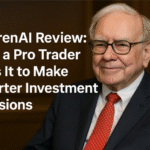
In 2025, retail traders are increasingly turning to managed futures ETFs like BlackRock’s iShares ISMF to navigate volatile markets with confidence. Unlike traditional equity-based strategies, managed futures ETFs are designed to perform well across different market conditions—bullish, bearish, or sideways. The ISMF fund, backed by BlackRock’s institutional insight and algorithmic models, offers exposure to a diversified mix of futures contracts while minimizing risk. As investors seek smarter, AI-enhanced tools, ETFs like ISMF are transforming how retail traders build resilient, adaptive portfolios. In this post, we’ll break down how ISMF works and why it’s gaining traction among modern investors.
👋 Hi there! What’s going on with the ISMF, and why is it creating a stir among independent traders? Let’s find out!
🤔 What’s This BlackRock iShares ISMF Thing?
ISMF’s like an actively managed futures ETF where it’s going long or short futures contracts in various asset classes—equities, commodities, currencies, and bonds—based on whether or not those asset classes will go up or down. What’s its purpose? To profit regardless of whether the market’s going up or down by riding those moves.
So this ETF is about replicating a trading strategy CTAs have used forever. But the great thing about this one is that ISMF makes it really simple for ordinary people like us to get in with a single click and a brokerage account.
🌍 Why Managed Futures in 2025?
As inflation persists, geopolitical intrigue unfolds, and interest rates rise, diversifying your investments beyond stocks and bonds isn’t merely a good notion—it’s a necessity.
Managed futures truly shine in times of turbulence. They completely capitalize on marketplace miscues and have performed rather well while run-of-the-mill portfolios have struggled. Consider 2022 and 2023 alone: inflation hit the stratosphere, technology stocks plunged, and bonds weren’t fantastic either. Managed futures were really one of the few bright spots in those couple of years.
📈 With 2025 around the corner and all this new insanity from global changes, things like ISMF are looking good for three reasons:
- 🔁 Uncorrelated returns
- 📊 Built-in trend-following strategy
- 💧 Daily liquidity and transparency
⚙️ How ISMF Works
ISMF applies these number-crunching models to analyze price movements. It doesn’t play a guessing game of predicting what the marketplace will or will not do.
For example:
- 🪙 If the price of gold increases, ISMF can come in and purchase some futures in gold.
- 💶 If the euro loses value relative to the dollar, ISMF may short euro futures.
That makes ISMF extremely versatile. ISMF can change things up as things change with the trend. The ETF tends to change exposure monthly, but can definitely respond more frequently to model signals.
Access our Live Forex Chart to analyze major currency pairs in real-time. Use interactive tools to track trends and make informed trading decisions.
🔍 ISMF vs. Traditional ETFs: What’s the Lowdown?
Most ETFs are purely long-only, meaning they only profit when prices rise. However, ISMF is not; it’s able to go short through futures contracts. That means it could potentially earn money when the market is falling.
📊 Let’s see:
- 📈 Traditional S&P 500 ETF (such as SPY): It rises when stocks rise and declines when stocks fall.
- 🔄 ISMF: Can go long or short on multiple asset classes, offering more flexibility.
That’s what makes ISMF so useful in those bear markets and market downturns when long-only ETFs may falter.
💡 Benefits for Retail Traders
Here’s the lowdown on why ISMF completely outshines smart retail traders:
- 🌐 Integrated Divers
ISMF provides exposure to a group of markets with a single position. This allows smaller traders to access alternative strategies without the inconvenience of opening multiple futures accounts or monitoring numerous assets. - 🛡️ Downside Protection
So if the shares go down, ISMF short sells or blends it with things like commodities or currencies. That completely makes sense in terms of diversifying normal portfolios. - 💸 Low Capital Requirements
You do not have to invest a fortune to get into futures trading. You can simply pick up a share of ISMF for under $100 (as of 2025). - 🧾 Simplicity and Tax Savings
Because ISMF trades like a stock, it avoids all that futures margin complexity, rollovers, or K-1 tax forms. It fits directly into taxable or retirement accounts without any issues. - 🔍 Openness
Unlike some hedge funds or mutual funds, ISMF publishes its holdings daily. This transparency helps retail traders understand their exposure and risk.
⚠️ Risks and Considerations
There is no perfect plan, and ISMF isn’t an exception. These are some things traders need to pay attention to:
- 🔄 Choppy Markets: Trend-following strategies like ISMF may underperform in sideways markets with no clear direction.
- 🕒 Model Lag: Quantitative models can be slow to respond to sudden reversals.
- 📉 Leverage Risk: Thus, ISMF employs futures but typically isn’t extremely leveraged. Nevertheless, futures will be quite volatile.
- 📏 Tracking Error: ISMF may not perfectly replicate CTA performance due to ETF structure and regulations.
🧠 No Joke: Traders’ Utilization of ISMF
Have a look at some interesting ways traders apply ISMF in trading systems:
🖥️ Protecting Your Tech Investments
Retail investors with a tech-heavy portfolio use ISMF as a hedge against equity drawdowns. In times when tech stocks decline, ISMF may shift into short equity or long commodities, providing a counterbalance.
Explore our newest tools designed to enhance your Forex trading experience effortlessly. Check HERE
🧘 Combining Alpha into a Relaxing Game Plan
Buy-and-hold investors toss ISMF into a traditional 60/40 portfolio to juice returns during inflation or in times of stress. Its trend-following bent can be a huge performance enhancer when other assets are underperforming.
📅 Trading Strategies During Major Events
During economic releases (e.g., CPI or jobs data), traders use ISMF as a safer exposure to volatile moves across currencies, commodities, or bonds, without having to manage multiple futures contracts.
🧑💼 Pro’s Opinion
There’s a 2025 Morningstar report that states:
Managed futures ETFs such as ISMF are absolute necessities in portfolios today. They offer flexible risk-adjusted returns and allow individual investors to access those high-quality strategies.
🚫 This isn’t a fad.
✅ It’s a structural shift in how retail traders allocate capital.
🔄 Alternatives to ISMF
If you’re considering ISMF, you may also want to look into:
- 🏔️ KFA Mount Lucas Managed Futures Index Strategy ETF (KMLM)
- 📉 Simplified Managed Futures Strategy ETF (CTA)
- 🌾 WisdomTree Enhanced Commodity Strategy Fund (GCC)
Each has different methodologies, asset exposures, and risk profiles.
🏁 Final Thoughts: ISMF Is a Retail Game-Changer
The democratization of complex financial strategies continues in 2025, and ISMF is leading the charge. For the average trader looking to gain dynamic, trend-based exposure without managing multiple futures contracts or enduring institutional hurdles, ISMF is a powerful tool.
🃏 BlackRock’s iShares ISMF isn’t an ordinary ETF; it’s your ace up the sleeve for smarter trading in a wild market, combining options, sound strategy, and convenient availability of managed futures.
🔗 Internal Links to Explore:
- 📌 Top ETF Strategies for Volatile Markets in 2025
- 🔄 Futures vs ETFs: What Should Retail Traders Choose?
- 💼 Best Brokers for Managed Futures and Commodity ETFs
Are you using ETFs like ISMF to enhance your strategy? Drop your thoughts in the comments or explore more ETF breakdowns at Tradingviews.blog 💬✨



It’s exhausting to search out educated individuals on this subject, however you sound like you already know what you’re speaking about! Thanks
I truly appreciate this post. I¦ve been looking everywhere for this! Thank goodness I found it on Bing. You’ve made my day! Thank you again